Miguel Angel Ramirez is certainly one of those coaches that are flying way under everyone’s radar but in a fair world, he’d be among the very elite people in football. The now 36-year-old gaffer cannot really boast with an overly impressive CV. After all, his only real stint in Europe was as the academy coach at Las Palmas in La Liga and now, he’s leading a relatively small Ecuadorian club named Independiente del Valle.
Chances are, you haven’t even heard of either his or the club’s name and no one could even blame you for it. After all, it wasn’t until recently that Ramírez has started to attract some attention from the rest of the world despite being one of the most exciting South American coaches on the planet.
The reason for this relative anonymity might hide in the fact that the 36-year-old is not at the helm of a Brazilian or an Argentinian giant, which is where everyone’s interest usually goes when talking about South American football.
Ramírez, however, is slowly but surely advancing up the ranks and becoming the most wanted man on the continent due to his extraordinary attacking tactics and thrilling football that combines a well-structured philosophy and trust in the youth.
For that reason, this tactical analysis will dissect Independiente del Valle’s style of play, focusing on both on and off the ball tactics the coach likes to deploy.
Attacking style of play
We’ll start the analysis by taking a look at Independiente del Valle’s attacking style of play. However, since the Ecuadorian club boasts unique offensive structures that include the use of a goalkeeper, we’ve decided to divide this part into two separate sections: the use of the goalkeeper and the build-up tactics.
The former is self-explanatory and will look into how Ramírez sees the goalie as an additional outfield player. The latter, however, to keep it simpler, will comprise both of the build-up phase and the final third tactics.
Since all three phases are undeniably interlinked, we can categorise them all as part of the overall attacking system.
The goalkeeper as an outfield player
Independiente del Valle usually rotate between two goalkeepers – Jorge Pinos, the 31-year-old veteran, and Moisés Ramírez, the 20-year-old talent. But regardless of who’s fielded on the pitch, the tactics remain the same.
Ramírez loves to instruct his keepers to push out of their box and combine with the two central defenders and a dropping pivot. Usually, this is the core and the platform on which Independiente build their attacks.
Below, you can see a graphical representation of a fairly usual setup in the first phase of play that involves the goalkeeper.
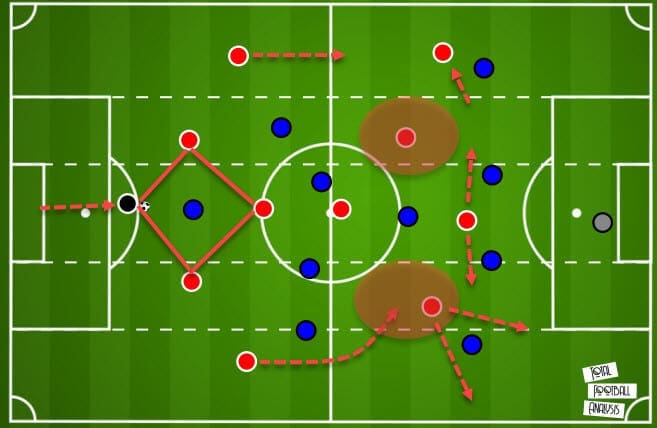
Several main points need to be observed here. Firstly, the diamond that is forming between the goalkeeper, two centre-backs and the pivot, the positioning and the movement of the full-backs and the space occupation higher up the pitch.
This image serves both as a great example of the setup in the first phase but also showcases the roles of the players higher up the pitch, which we will explain in more detail later in the tactical analysis.
The positioning of the goalkeeper so high has two different purposes. Firstly, it ensures Ramírez’s squad has numerical superiority against the pressing team, whether they defend with one, two or even three players in the first line. But secondly, it also means the pivot doesn’t have to drop between the centre-backs and can remain positioned higher up the pitch since the goalkeeper is effectively in a lavolpiana role here.
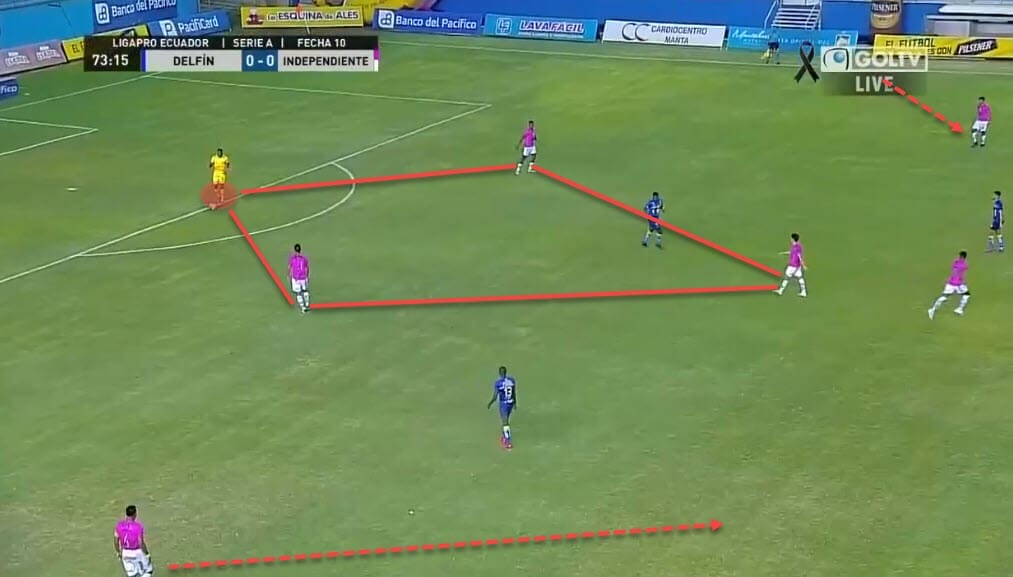
Above is an in-game example that will help us illustrate this a bit better. With the goalkeeper in possession of the ball and a diamond forming with the three other players, Independiente can smoothly bypass the opposition’s first line of defence.
Of course, this is something Ramírez likes to use in his philosophy even when faced with a much more aggressive form of a high press. In the previous two examples, we’ve seen the opposition sit in a mid-block with either one, two or three players in the first line at most.
However, Independiente del Valle’s use of the goalkeeper extends even to the high press scenarios. You can see a similar example down below as they are pressed by four opposition players deep into their own area.
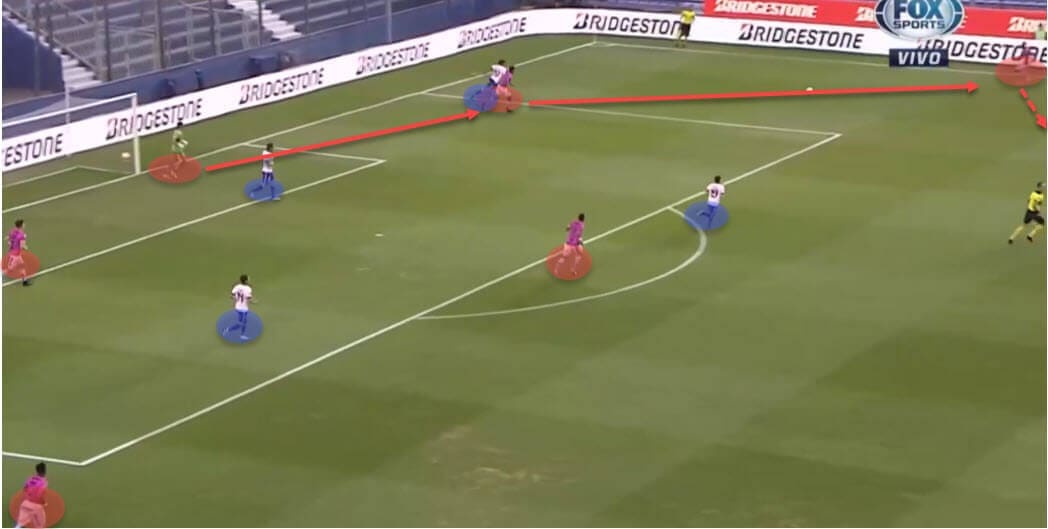
But since they use the goalie as an outfield player, essentially making him a valve to release the pressure and recycle the ball, Independiente can escape the press and move possession towards the wide areas. From there, they can easily progress up the pitch.
A keen eye might have also noticed a very common occurrence in almost all of our previous examples – the inverted full-backs. The wide defenders are indeed crucial to Ramírez’s tactics, especially in the attacking phase of play, similarly to Manchester City for example.
During the build-up, they will occupy the half-spaces between the opposition’s lines, either between the first and the second or the second and the third, where they can receive the ball and then either run with it or pass it towards their forwards.
This is closely related to the goalkeeper tactics as well since the men between the posts also have to possess a wide passing range to potentially release the pressure with long balls over the top.
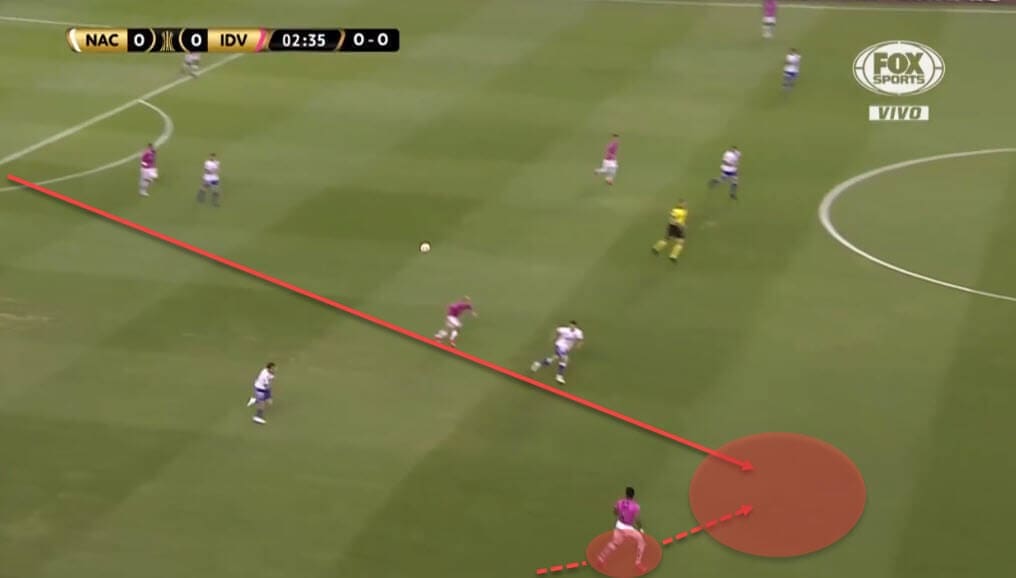
You can see such an example above as the right-back inverts into the pocket of space behind the opposition’s backs and the goalie finds him with a perfect pass that sets up the attack. After that, the player in possession can combine with the winger or the striker up front as Independiente del Valle continue the assault.
Build-up and final third tactics
Now that we have established how and why Ramírez likes to include the goalkeeper in the first phase of the attacking structure, we’ll take a look at some other patterns of play Independiente use higher up the pitch.
Before we delve deeper into the tactical analysis of said systems, let’s first inspect two of their passing maps from two different games in 2020. Both are very similar in structure and they will help us identify some of the core principles in their tactics even before looking at the footage itself.
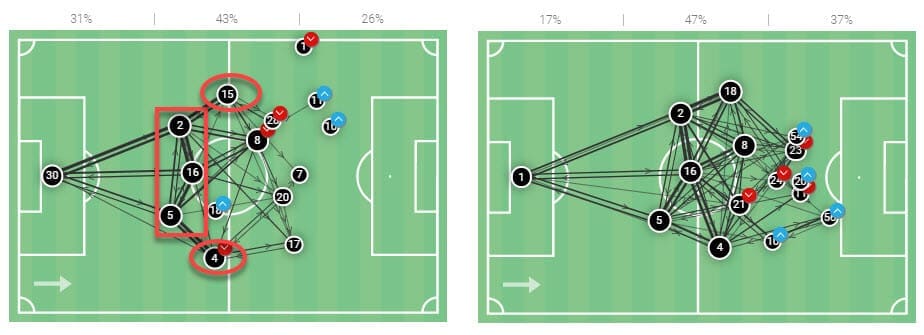
I’ve decided to highlight two main points of interest in the image – the backline with the support of a pivot and the positioning of the full-backs compared to the wingers. Ramírez has a clear structure in place in this phase of attack – the pivot will drop deeper and sometimes even between the centre-backs if necessary and this will ensure numerical superiority in the first phase of play against the opposition.
The full-backs, as you can see, can venture forward but will mostly stay in a more narrow, inverted position as opposed to the wingers. Of course, the wingers can and will occupy the half-space if it benefits the team but will mostly provide the width and stretch the backline.
We can see this general setup in a graphical representation below as well.
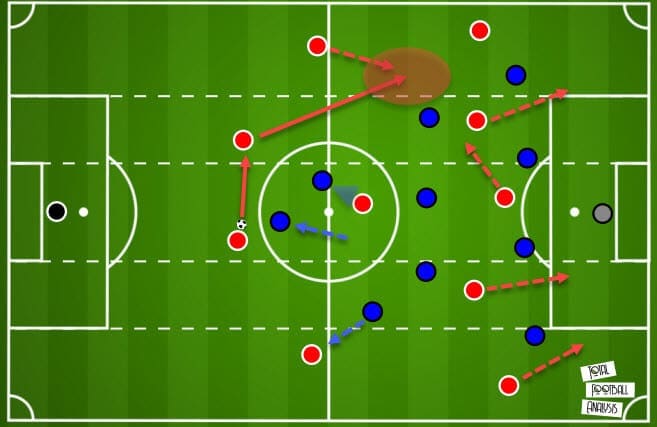
This is Independiente del Valle against a 4-4-2 mid-block and the ball is being recycled from right to left, as indicated by the positioning of the opponents’ second line. You can see that the ‘blue team’ has engaged a player from midfield to stop the ball going wide into the right-back. As a result, the ‘read team’ or Independiente in our case, are shifting towards the left across both centre-backs and into the full-back who’s inverting.
The positioning of the no.8s is also very important since they occupy the half-spaces higher up the pitch and are forcing their counterparts into a decisional crisis – does the centre-back step up to follow them, risking leaving space behind? Or is it the midfielder’s job to stick with the no.8 but then leave the full-back in space?
We can also mention the wingers, who stretch the backline and occupy the opposition full-backs and the movement of the centre-forward who will drift to either side depending on where the ball is being played to.
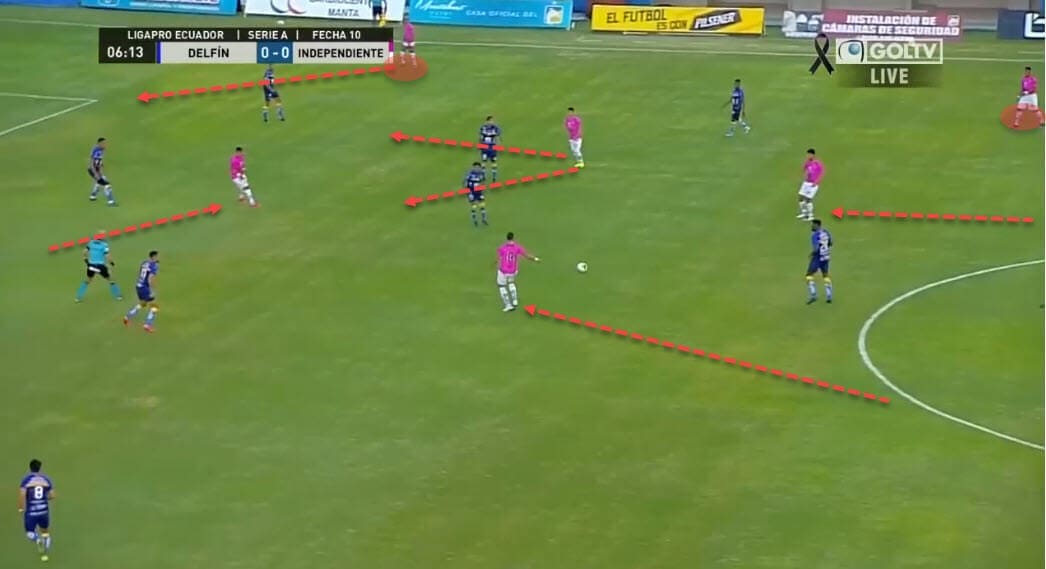
Above you can see a very similar structure, only this time we’re showing it in an in-game example from one of their recent matches. Here, the centre-back is actually advancing with the ball since Independiente have achieved numerical superiority for a smooth progression from the first line.
Notice the positioning of both wide players, highlighted with a red circle, and how the winger keeps the width high and wide while the right-back is deeper and more narrow. Interestingly, in this scenario, the pivot is also advancing from his deeper positioning so that he can receive the ball in a pocket of space.
This is a usual pattern of movement after the superiority has been established and the ball progressed past the first line of defence. Finally, note the positioning and movement of the no.8 who occupies the space between the lines and the centre-forward’s drifting run to an unmarked pocket of space.
And it’s the space between the lines that Ramírez values the most. Let’s look at a couple of examples next.
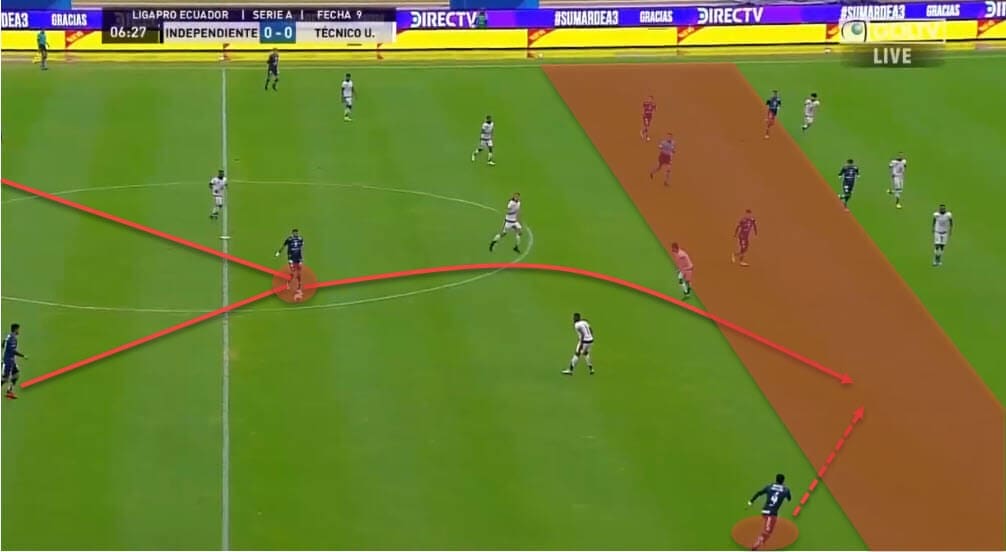
Here we see Independiente in their usual setup in the first phase of the build-up. We’ve got the pivot close to the centre-backs and upon progressing the ball beyond the opposition’s first line of defence, they are looking to progress it further.
Again, the full-back will invert to receive the ball between the lines but notice that almost all the attacking players are occupying that same area in the final third. Both the midfielders and the forwards will position themselves to be able to receive the ball there and this is key for Ramírez’s attacking tactics.
In the final third itself, there’s no strict plan to follow. Yes, proper space occupation and movement manipulation is key to Ramírez’s positional play but the players enjoy certain freedom in the final stages of the attack.
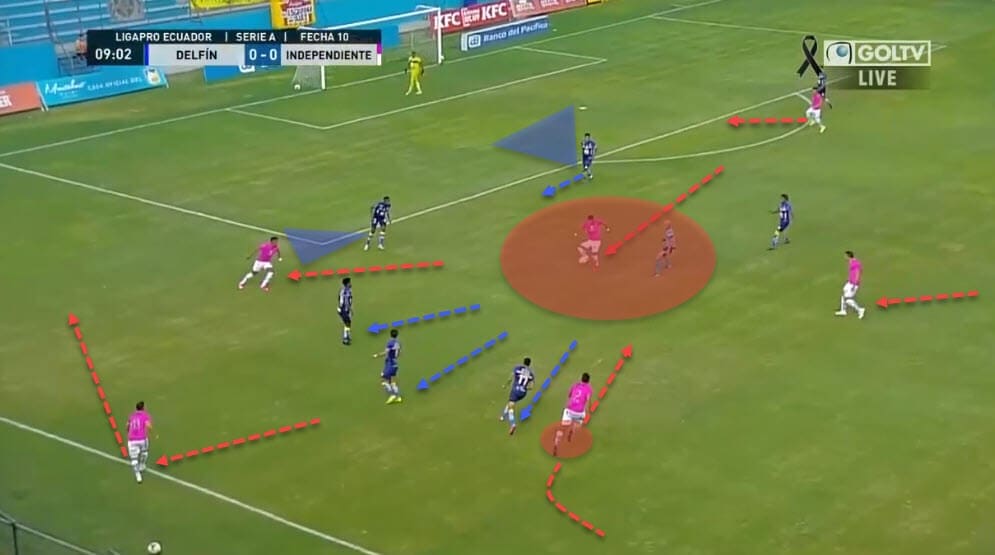
The example above, however, clearly depicts there is a system in place after all. The play starts from the inverted full-back once again, as it usually does. One of the midfielders is wide to occupy and attract the opposition defenders while the winger threatens to make a run from the half-space channel.
That movement, combined with the arrival of the full-back, manipulates the movement of the defensive block, creating a pocket of space for the striker to occupy. Also notice how both of the defenders on the edge of the box are essentially pinned down because if they leave their spot, a huge gap in the backline will be created.
These are, of course, just some of the principles Ramírez employs in his attacking tactics. Some of the others include long switches, for example. Generally speaking, Independiente del Valle prefer short passes that are deployed on the ground in true Barcelona fashion but are not completely averse to quickly swapping sides through long balls or going directly into space from the backline.
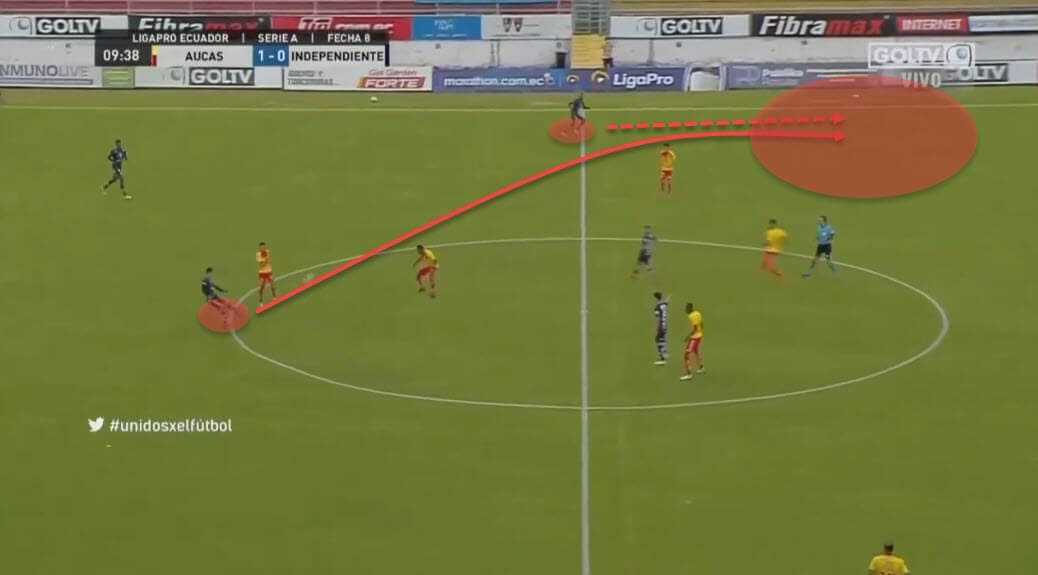
This, however, is not their primary source in attack and is merely a tool to get them into a more favourable position to continue on the offensive.
Defensive tactics & pressing
The final part of this tactical analysis on Miguel Ángel Ramírez will focus on Independiente del Valle’s defensive style of play. Generally speaking, they are a highly aggressive team that tends to press at all times in a heavy man-marking system.
Speaking of systems and structures, there’s no set template to follow but it does seem like Ramírez favours the 4-1-4-1 and even a 5-3-2 at times. This is because these formations lend themselves nicely to pressing structures, especially the former one which is the more aggressive of the two.
We can see an example of that in the image below. Independiente start their defensive phase in a 4-1-4-1 system and initially, only the centre-forward is putting pressure on the opposition’s backline.
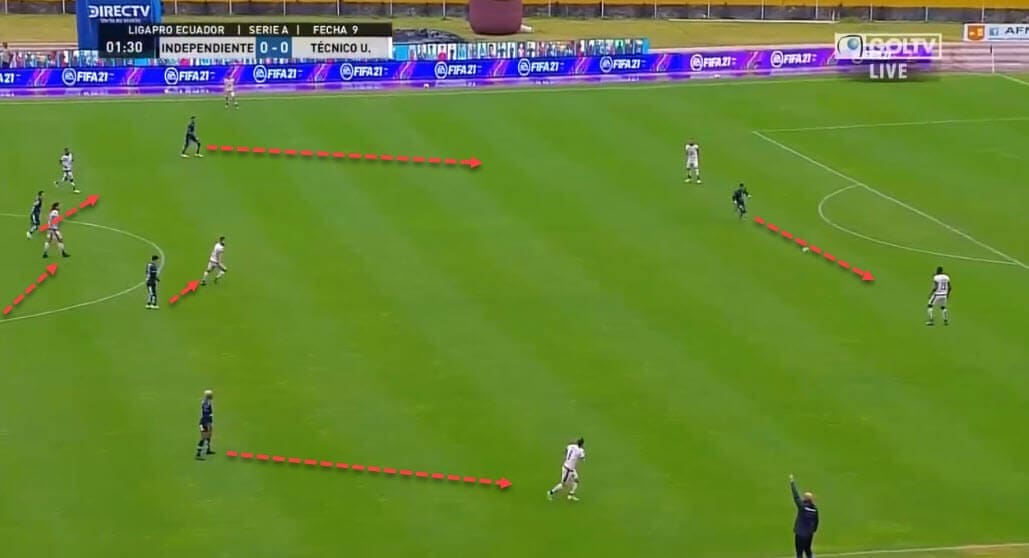
However, as the ball is slowly guided towards the wide areas where a collapse is more realistic, we can see other players sticking to their markers and the squad as a whole moving up the pitch in a man-marking pressing scheme.
This usually translates into almost every opposition player having a marker tightly on him at all times, which can result in blind clearances and forcing mistakes in possession. The wingers will occupy the full-backs while the central midfielders push up and mark their counterparts.
What we can’t see from the image above is the backline which is also pushing up and the additional players that are collapsing from the deep as the opposition try to drop more players to ease the progression of the ball. Eventually, they are forced into a long ball that ends up losing them possession.
The next image could give us a clearer depiction of that heavy man-marking scheme.
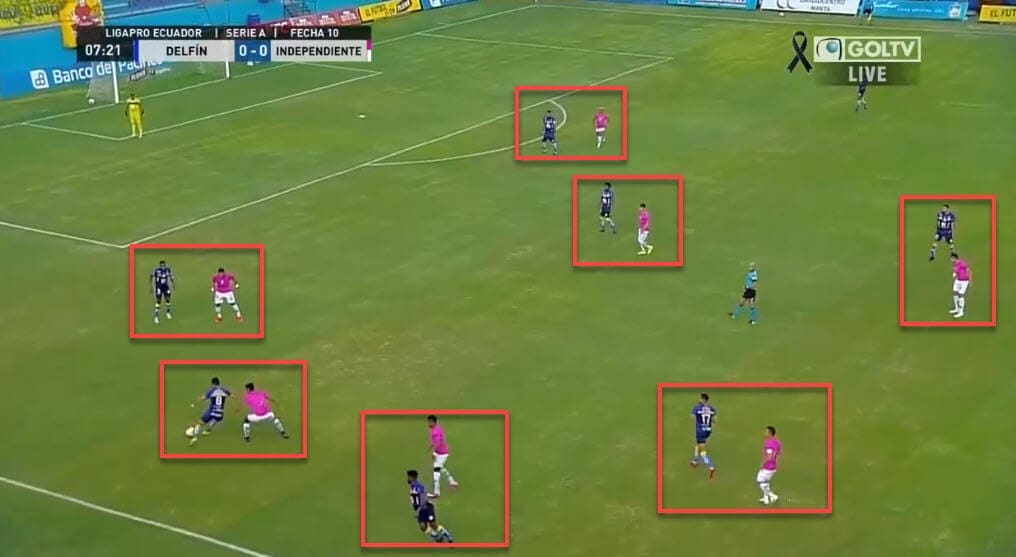
This time, you can see clearly this insistence on keeping every opposition player tightly marked when pushing up the pitch. The only free man is on the opposite side of the field but he cannot be reached because all the channels towards him are closed.
Of course, theoretically, a long switch would be possible given the ball-carrier’s body shape but Independiente are putting immediate pressure on the player so precision cannot be guaranteed and therefore it represents a very risky manoeuvre.
The final thing we have to discuss briefly is counter-pressing. Ramírez seems to be adamant on winning the ball high up the pitch from where his team can then transition into the attacking phase immediately.
Since they are extremely dominant on the ball and usually control the possession, most of their losses happen in the final third anyway so counter-pressing is the best weapon to stop the opposition’s counter-attacks and start their own transition.
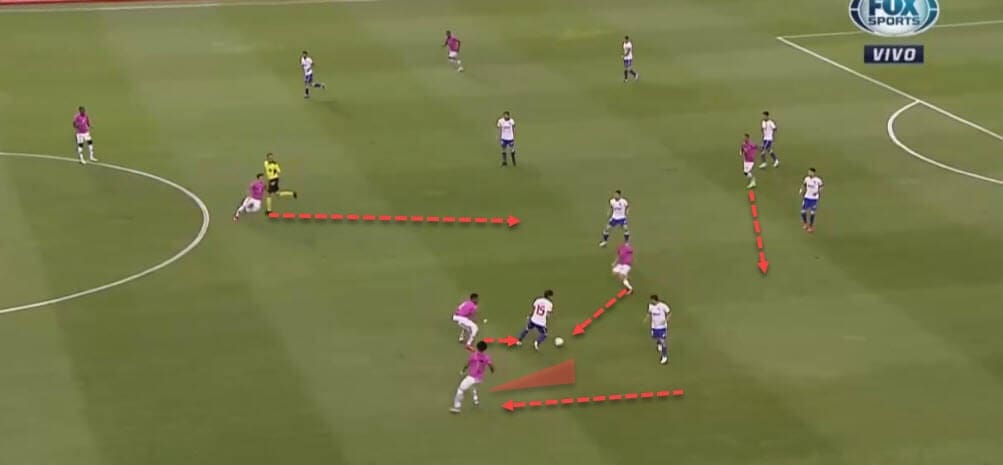
We can see such a situation above as Independiente lose the ball in the final third but as soon as the opposition try to start their transition, Ramírez’s troops are already collapsing and blocking passing channels at the same time.
That is a somewhat usual type of movement we see from Independiente but apart from simply hunting for the ball immediately after losing it, they do have a set rest-defence in place to make that process easier.
For instance, in the example below, they once again give up possession just outside the box but their midfielders are already in place to push up and recover the ball to continue the attack.
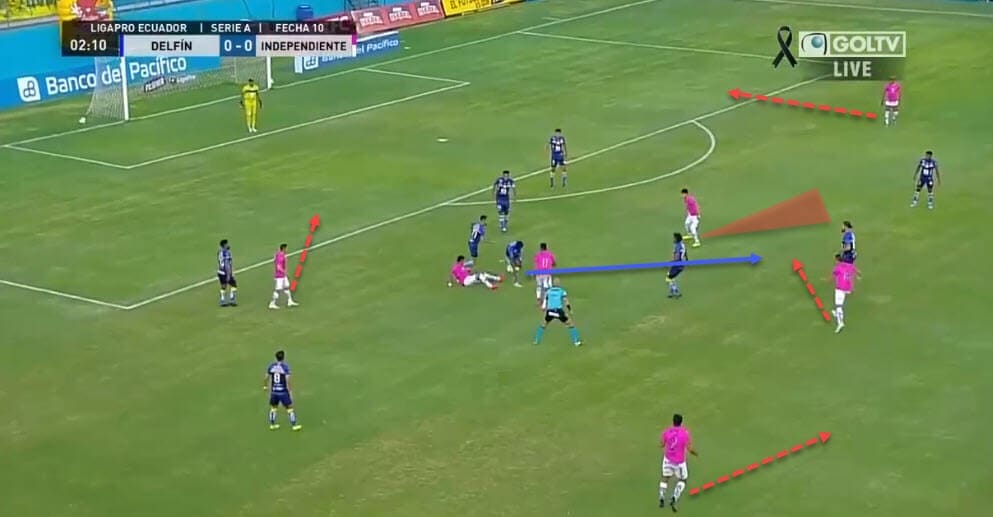
This still feels like a work in progress at times since just a year ago, Independiente’s structure didn’t exactly lend itself to transitions and immediate counter-pressing that well. Now, however, Ramírez has built a system that thrives in such scenarios and it enables them to be as dominant as they are.
Final remarks
Miguel Ángel Ramírez is a name not many are familiar with but if he keeps performing on such a high level, this will most certainly change sooner rather than later. Independiente del Valle are a club that cultivates the youth and has a philosophy set in stone.
Ramírez’s tactics are exhilarating, brave and to a certain extent innovative as well, especially for the region he plays in. So far, we have no idea whether he’ll eventually make a switch to Europe but it would have to be a very specific club that can give him the time and the freedom to create a project of his liking.
Let’s hope someone decides to bet on this young coach on the rise.






Comments